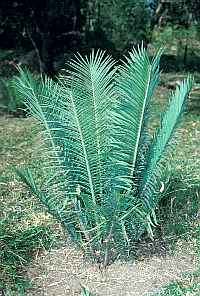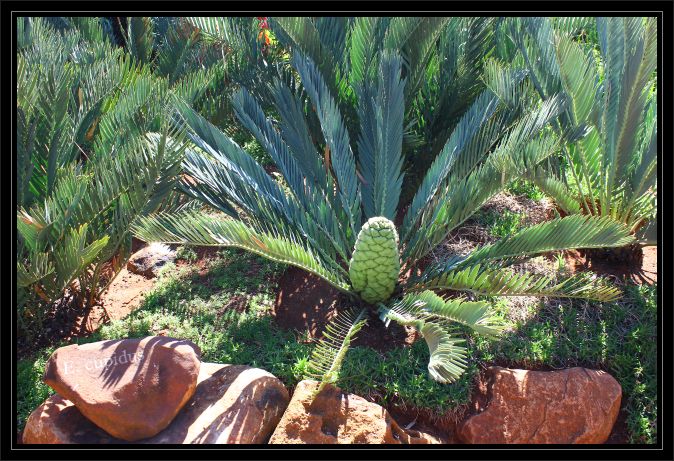E. cycadifolius
The maximum height of the stem of E. cycadifolius is approximately 1,5m but more commonly less than 1m, with a diameter of approximately 25cm. In nature up to two thirds of the stem may be covered by soil. Numerous basal suckers are formed to create clusters of up to 10 or more stems from the same rootstock. Damage to the crown of the stem sometimes results in multi-headed stems.


The dark olive-green leaves are 60cm to 1m long, with bare petioles of 10cm to 20cm long. The leaf stalk is usually slightly spiraled, giving the leaf a characteristic twist. The leaf stalks, especially the older ones, are yellow to orange in colour. The whole leaf is covered by fine white wool when young, but these are lost with age. The leaf stalk of dead leaves remains on the plant for many months and hang around the stem.

The median pinnae are 9cm to 13cm long and 4mm to 6mm broad. The leaflets have smooth, thickened edges and no thorns and are attached to the rachis in the form of a wide V, with no or very little overlapping. The leaflets are reduced in size towards the base and the tip of the leaf.
One or two cones on short stalks are formed in male and female plants. The yellow cones are covered with a thick layer of greyish white hair, which becomes brown with age. In multi-stemmed plants, only one or two of the stems will form cones at the same time. The male cone is more or less cylindrical in shape, 13cm to 22cm long and 5cm to 8cm in diameter. The nose of the cone scale projects only slightly. The median cone scales are approximately 2cm long and 1,8cm broad. The more or less barrel-shaped female cone is 20cm to 30cm long and 16cm to 18cm in diameter. The median cone scales are 4mm to 4,5mm long and 4mm broad, with a flattened face. The seeds are orange-yellow through orange to amber-brown in colour.
 Distribution and Habitat
Distribution and Habitat
E. cycadifolius has a restricted and narrow distribution range which includes a few areas on the Winterberg mountain range in the districts of Bedford and Cradock.
Plants grow on mountainsides, usually on exposed northern and eastern slopes, at altitudes of up to 1800m. Winter temperatures drop to -6 °C and lower, and snow and frost occur frequently. In this respect, the species share a similar habitat with other species with narrow leaflets such as E. friderici-guilielmi and E. ghellinckii. Rain falls in summer, at an average of 625mm and 800mm per year. Lengthy periods of drought are not uncommon, however, plants are often hidden away in the grass and many grow in-between rocks, which offer them shade and protection against cold, fire and porcupines. The blackened stems of older plants attest to the occurrence of veld fires, to which the species is well adapted. There are strong indications that fire serves as a stimulus for leaf and cone development. In Bothalia, Vol. 8, part 4 of 1965, Dr Dyer recounts the observations of Mr. V.L. Pringle, who noticed that E. cycadifolius plants formed new leaves soon after a veld fire and were "looking better than ever before". Mr. Pringle continues: "There is scarcely one in hundreds which has not fruited."



Love the stone tag.









